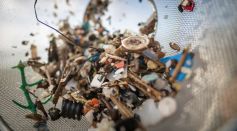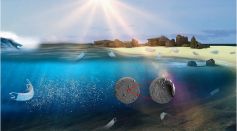Tags: Microplastics

Drinking from Plastic Bottles Could Make Us Ingest Nearly 100,000 Micro and Nanoplastics Every Year

Less-Toxic Approach to Eliminate Microplastics in Drinking and Wastewater Developed Through Okra

Microplastics Found in Human Blood For The First Time; How Do These Tiny Particles Affect Our Health?

Nano-Sized Plastics Penetrate, Permeate Human Cell Membranes

New Quantitative Method Detected More Plastic Particles in Salads Than Previously Thought
NASA Satellite Data Tracks Microplastics With Nearly 8 Million Tons Flowing From Rivers to Oceans Annually

Microplastics Act As Breeding Ground for Antibiotic-Resistant Bacteria, Study Reveals

Disposable Masks Bring More Microplastics to the Planet's Oceans

Babies are Pooping Microplastics: Study Reveals Infants' Dirty Diapers Contain Plastics 10 Times More Than Adults

Sunlight Exposure for 100 Hours or Less Melts Plastics, Breaks Them Down Into Smaller Soup of New Chemicals

Seafood and Plastics: How Microplastic Pollution Acts as 'Trojan Horse' to Marine Life and Ecology

Uncooked Rice May Contain Harmful Microplastics, Sparking Health Fears to Millions of Consumers
Microplastics Discovered in Europe's Largest Ice Cap Can Be Distributed Through the Atmosphere

Track Marine Litter Anywhere in the World With This New Interactive Website

84% of Atmospheric Microplastics Produced by Roads and Vehicles Affect Plants, Oceans, and Even Humans

Is Ocean Pollution a Danger to Human Health? Experts Weigh In

Chemist Explains How Oil is Turned into Plastic
Novel Catalyst Turns Plastic into Fuel and Wax
Microplastics in Seafood, Should We Be Worried?
Did Doctors Just Found Microplastics Inside the Placenta?
Most Popular

Will Earth's Magnetic Poles Flip Next? Magnetic Pole Reversal Explained Through Cutting‑Edge Magnetosphere Science

Relativity Time Dilation Explained: The Physics of Time and Why It Moves Differently in Space

How Lightning Science Reveals Why Charged Storms Are Rising with Global Warming Effects

De-Extinction vs. Conservation Science: Which Approach Protects Biodiversity Most Effectively?





